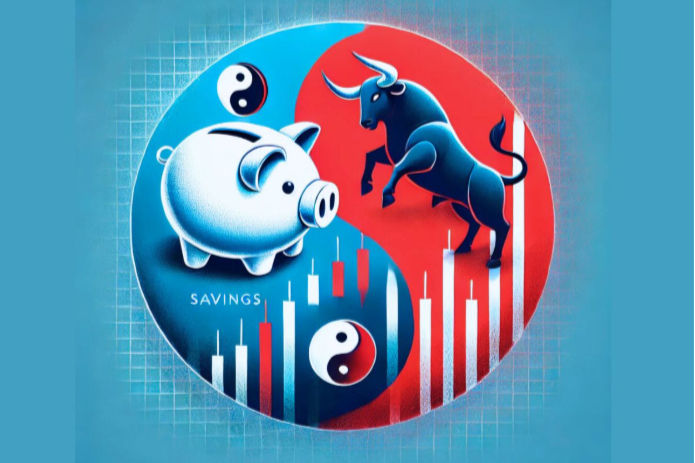Saving is Safe, Investing Isn’t: Busting the Myths
- CONTENT28 Team
- Feb 1
- 4 min read
Updated: Apr 21

Ah, savings and investments—the beloved yin and yang of our financial universe! Imagine them as two siblings: savings, the cautious elder who insists on safety and security, and investments, the wild child always chasing the next big thrill.
While we often turn to savings for their steadiness, investments can get a bad rap, like a distant cousin who shows up at the family reunion with a questionable haircut and a penchant for risky business.
The ‘Safe’ Side: The Indian Mentality Towards Savings
In India, there’s a long-standing love affair with the idea of saving. The notion of “saving for a rainy day” is practically etched into our collective consciousness—almost like a badge of honor.
According to a report by the Securities and Exchange Board of India (SEBI), around 65% of Indian households prefer keeping their savings in cash or savings accounts, viewing these options as the safest. But hold your horses!
Do you really think cash is king? Let’s talk about the great Indian obsession with fixed deposits (FDs). Sure, they offer safety (like a cosy blanket on a cold night). Still, with inflation currently hovering around 5% (per the SBI), your money is going for a leisurely stroll while inflation races ahead. So, while you’re sipping chai, your money is losing its purchasing power faster than you can say, “How much for a loaf of bread?”
Investing: The Villain or the Hero?
Now, let’s pivot to our wild child—investing. Many people associate investing with horror stories of market crashes, akin to tales of ghosts in the attic. The prevailing belief is that investing is akin to stepping into a financial casino. But did you know the S&P 500 has delivered an average annual return of 12.39% over the last 10 years (2013-2023)?
A stellar example of the Indian stock market’s remarkable performance can be found in a report by Helios, a Singapore-based asset management firm. According to the data, the Nifty 500 index has outshone none other than Warren Buffett’s Berkshire Hathaway, delivering an impressive 12.56% annual return between July 31, 1999, and July 31, 2024, in US Dollar terms. Compare that to Berkshire Hathaway’s 9.52%, and you’ve got a clear winner in the Nifty 500.
And it doesn’t stop there—since January 1, 1995, the Nifty 500 Total Returns Index (TRI) has delivered annualized returns of a solid 12.6%. This isn’t just a victory; it’s a resounding declaration that Indian equities aren’t just competing on the global stage—they’re thriving and leading the charge!
Let’s also take a trip down memory lane to the great Indian stock market crash of 2008. Picture this: the Lehman Brothers collapse sends shockwaves through global markets. Suddenly, everyone is donning the role of a financial advisor, warning against investing. But guess what? The market recovered. In fact, it bounced back stronger than ever. The lesson? Investing isn’t the enemy; it’s merely misunderstood.
The Generational Divide: Saving vs. Investing
Traditionally, many have adhered to the safety net of savings. “Why risk it?” they ask, clutching their trusty piggy banks. Meanwhile, millennials and Gen Z are shaking things up, treating investments as the new normal.
According to the latest data from the National Stock Exchange (NSE), 40% of young Indians under 30 are now diving headfirst into the stock market. And here’s the kicker: the median age of investors, which sat at a respectable 38 years in March 2018, has dropped to a sprightly 32 by March 2024. It’s like the younger generation is saying, “Move over, boomers! We’re not just here to save; we’re here to play the market and win.” It’s the ultimate coming-of-age story—except this time, it’s happening in the world of equities, where the thrill of risk is becoming the new ‘cool.’
The Reality Check: Myth-Busting with Data
It’s time to bust a few myths about saving versus investing, armed with data and a splash of humor:
Myth 1: Saving is Always Safer
Reality: Interest rates on savings accounts typically range from 2.6% per annum to 8% per annum, depending on the bank and the balance maintained. However, reality check: savings accounts may feel like a safe harbour, but with interest rates often lower than inflation, your money is like a boat slowly sinking. So, if inflation is at 5%, guess what? You’re effectively losing money. It’s a classic case of “saving but not saving,” where your hard-earned cash is just treading water!
Myth 2: Investing is Only for the Rich
Reality: This is akin to saying good food is only for Michelin-star restaurants! You can start investing with as little as ₹500 in mutual funds through Systematic Investment Plans (SIPs). It’s like saying, “I’ll only eat biryani if it’s served in a silver bowl.” Nope! Grab that plate!
Myth 3: You Can’t Time the Market
Reality: True, but you also can’t time your next coffee break! While it’s advised not to try to time the market, investing consistently over time (like a disciplined chai drinker) can yield impressive results. The SIP route often smooths out market volatility, allowing you to invest without fear.
Saving vs. Investing – The Punchline
At the end of the day, it’s not about choosing between saving and investing; it’s about finding a balance. Just like a good masala chai, you need both the tea and the spices to make it flavorful. Savings provide the safety net, while investments offer growth opportunities.
So, the next time someone tells you, “Investing is risky,” just smile and say, “Saving is safe, but it’s a bit like watching paint dry.” Grab your financial future by the horns and embrace the wild side of investing. Your future self will thank you—ideally while sipping a fancy latte at a café rather than counting coins at the end of the month!
For a different take on the same topic, click here.
Disclaimer: This content is the sole property of CONTENT28. Any unauthorised copying, reproduction, or distribution is strictly prohibited. This material is intended for reference purposes only and should not be replicated or used without prior permission.




Comments